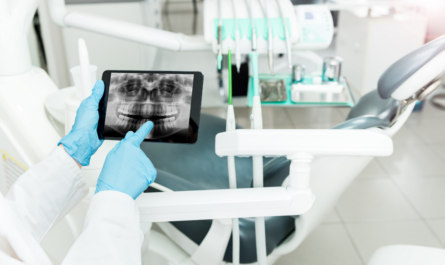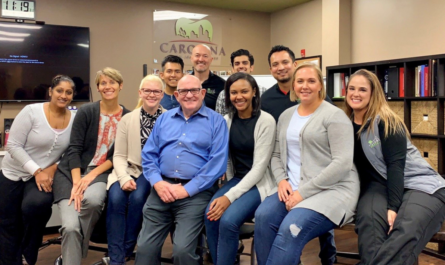Sponsored Content: Denti.Ai
By Dr. Adam Burr, DDS, Principal Advisor, Denti.AI
With Denti.AI’s clinical productivity suite, practices can generate more than $11,000 per month in additional gross profit while turning quality oversight into an objective, repeatable, and scalable process.
Maintaining consistent clinical quality in a single practice is difficult and subjective. As organizations grow, variability in diagnosis, documentation, and treatment expands. This leads to compromised patient care, clinician frustration, and uneven financial performance. This article demonstrates how three Denti.AI solutions, Voice Perio, Scribe, and Detect + Auto-Chart, establish clear and repeatable systems that scale across any enterprise. The results are higher, achievable clinical standards, enhanced operational support, and improved financial outcomes.
Quality Challenge #1 – Periodontal Charting Compliance
Capturing a comprehensive periodontal chart with every parameter is challenging. The ADA standard of care is to perform this annually for all adult patients, and more frequently for at-risk patients. Time constraints, staffing limits, and manual entry pressures many teams to skip comprehensive periodontal charting. Teams often opt for charting pocket depths only. Pocket depths in isolation are an inadequate diagnostic measure. These clinical inadequacies severely restrict the ability to diagnose periodontal disease accurately and consistently.
AI Solution #1 – Denti.AI Voice Perio
Denti.AI Voice Perio enables comprehensive periodontal charting in under five minutes without requiring an assistant. This efficiency makes it realistic for teams to meet the ADA standard of care for annual full-mouth charting and for more frequent assessments of at-risk patients.
Each charting session generates a calibrated patient-facing Periodontal Health Index (PHI) report, staging and grading their disease status per the 2017 AAP guidelines. Concurrently, leaders gain oversight through management dashboards that track utilization, audit findings, and treatment behaviors across providers.

By combining speed, accuracy, and scalable oversight, Voice Perio empowers clinicians to standardize periodontal protocols and elevate diagnostic consistency across the enterprise.
Clinical Outcome #1 – Enhanced Periodontal Identification and Treatment
Frequent, comprehensive periodontal charting enhances earlier identification and more effective maintenance of periodontal disease. By making unassisted comprehensive periodontal charting simple and efficient, AI helps transform an aspirational standard into a consistent and scalable clinical quality reality.
Financial Outcome #1 – Increased Revenue and Reduced Labor Cost
More frequent and consistent diagnostics increase the discovery of treatable disease, directly increasing revenue. By reducing staff involvement in charting, practices expand gross profit through lower administrative labor. Since most periodontal therapy is performed within hygiene and specialty departments, additional revenue flows against controlled labor costs and fixed overhead, so gross profit margins expand further at scale.
Operational Outcome #1 – Achievable, Ethical Clinical Quality Oversight
Management dashboards provide leaders with objective data to compare performance across locations. Outlier detection highlights where targeted clinical training is needed, ensuring consistent care delivery. With unmatched insight, lofty standards of care become attainable clinical outcomes.
Quality Challenge #2 – Insufficient Clinical Notes and Disrupted Care
Complete, well-structured notes are essential for clinical outcomes, continuity of care, and legal integrity. Time pressure, language barriers, clinician habits, and outdated software often push teams toward templates and checkboxes. These efficient shortcuts omit clinical nuance, conversational context, and true informed consent, leading to incomplete or inaccurate records. The results are care gaps, communication breakdowns, and diminished patient trust. These consequences amplify as organizations grow and clinical teams evolve.
AI Solution #2 – Denti.AI Scribe
Denti.AI Scribe captures patient-clinician conversations and transcribes them into the note format chosen by the clinical team. Complex medical histories, patient concerns, multidisciplinary treatment plans, and long procedures are summarized with minimal staff effort. The tool supports multiple outputs including SOAP formats, custom templates, narrative summaries, and verbatim dictations. It also functions seamlessly across 57 languages and diverse dialects, ensuring accuracy and consistency in every clinical interaction regardless of organizational size.

Clinical Outcome #2 – Richer Records, Better Continuity
AI-generated notes improve adherence to complex, multi-stage, interdisciplinary care plans. Comprehensive documentation ensures patients consistently hear procedural expectations, likely treatment outcomes, and any changes to the plan.
This builds trust in the clinical team. When clinical teams grow or when staff changes occur, new team members can quickly access the full context of the patient’s history and care without scrambling for missing details. Continuity becomes the default standard rather than an occasional achievement.
Financial Outcome #2 – Time Savings and Medico-Legal Protection
Clinicians and staff save valuable minutes during each patient encounter by reducing the effort required to create comprehensive notes. These time savings lower labor costs and improve efficiency by freeing staff to focus on other essential tasks. Standardized, defensible documentation also reduces medico-legal risk. In addition, accurate records minimize costly rework, patient misunderstandings, and potential refunds. Across any organization, the resulting savings are substantial.
Creative practice owners are using Scribe templates to better train treatment coordinators and to facilitate conversational handoffs between team members. They are experiencing positive revenue impacts while minimizing the variability inherent in these high-touch human exchanges.
Operational Outcome #2 – Scalable Documentation Standards
Similar to the current generation of software-enabled templates and checkboxes, Denti.AI Scribe creates uniform note quality across providers and locations. Unlike the current solutions, Scribe preserves narrative detail and clinical context while maintaining consistency. Multilingual capture and customizable outputs allow organizations to scale documentation standards across diverse teams and sites without sacrificing accuracy or efficiency.
Quality Challenge #3 – Incomplete Conditions Records and Inconsistent X-ray Diagnosis
Documenting existing conditions and prior treatments as a dental history is a legal requirement that takes significant time and effort. Radiographic findings such as incipient decay, bone loss, and open margins are often skipped or assumed in the treatment plan. Accurate charting requires switching between photos, X-rays, 3D scans, and the visual exam, followed by verbally dictating or writing notes on paper that must be re-entered into the digital record. The burden leads many clinicians to omit findings or place them on an ineffective “watch list” that gets buried in narratives or marked with unclear symbols. These gaps create inconsistent diagnoses, inadequate informed consent, and confusion for future providers, which compromise patient care.
AI Solution #3 – Denti.AI Detect + Auto-Chart
Denti.AI Detect highlights conditions with visual overlays that patients can understand. This helps to build trust and improves case acceptance. Clinical leaders can establish objective treatment protocols tied to measurable thresholds, such as quantified interproximal bone loss, lesion depth, or AI confidence scores. Treatment outcomes from modalities such as application of caries arresting medicaments (D1354, D1355) or application of hydroxyapatite regeneration medicament (D2991) are easily implemented by teams and readily accepted by patients. Monitoring the success of those treatments is facilitated with future objective evaluation.
Denti.AI Auto-Chart reduces both the manual effort and administrative output by auto-populating existing conditions and proposed treatments directly into the digital record. This feature, along with the other features mentioned in this article has direct integrations with every major practice management software.

Clinical Outcome #3 – Proactive Diagnosis and Documentation
AI-assisted diagnostic tools like Denti.AI Detect make early disease identification both practical and consistent. Patients are more likely to accept care when they can clearly see visual overlays that transform X-rays from indistinct grayscale images into understandable indicators of disease. This clarity builds trust and shifts the focus toward preventive, less invasive treatments. The outdated “watch” annotation becomes unnecessary as clinicians gain the confidence to diagnose earlier and intervene proactively.
Denti.AI Auto-Chart reinforces continuity by removing the burden of manual condition entry and ensuring precise documentation. As enterprises scale, practices grow, and providers change, the patient’s full clinical status remains accessible for the current care team and consistent across time, improving long-term outcomes.
Financial Outcome #3 – Expanded Revenue Lines and Labor Efficiencies
Earlier and more consistent disease identification is proven with AI-facilitated X-ray analysis such as Denti.AI Detect. Internal analysis shows an average 7% increase in traditional treatment modalities including fillings, scaling and root planing, and root canal therapy. Clinicians who adopt interceptive protocols such as D1354 and D2991 also create entirely new revenue streams.
In my private practice, more than 500 incipient cavities were treated with these two modalities in less than one year, generating over $20,000 in new service line revenue. This underscores how proactive intervention with Denti.AI Detect can directly translate into growth.
The benefits of Denti.AI Auto-Chart mirror those of Scribe by reducing administrative effort, lowering labor costs, and improving compliance. Together these efficiencies support higher revenue capture while freeing staff to focus on direct patient care.
Operational Outcome #3 – Objective and Auditable Standards of Care
Denti.AI Detect converts every image into structured findings that leaders can audit, track, and compare across time and locations. This makes it possible to identify targeted training needs and gaps in core clinical diagnostics. Dashboards highlight provider variation, surface missed findings, and confirm adherence to care protocols that are created and established by clinicians. Quality oversight evolves from a subjective, time-consuming process into an objective, repeatable, and teachable system that scales reliably across the enterprise.
Monthly Financial Impact of 3 Denti.AI Inputs for 1 Location, $125,000 Monthly Revenue
| AI Input | Revenue Impact | Labor Savings | Gross Profit4 Impact | EBITDA Impact5 |
| Voice Perio1 + Scribe2 | $6,720 | $613 | $7,333 | $1,466 |
| Detect + Auto-chart3 | $4,290 | $113 | $4,403 | $881 |
| Total | $11,010 | $726 | $11,736 | $2,347 |
Key Assumptions:
- Voice Perio: 28% increase in periodontal charting leads to an average $60 uplift per patient visit, driven by increased utilization of D4341, D4342, and D4346. Assumes 112 hygiene visits per month with 60% requiring charting. Labor savings are based on 5 minutes per chart at a $60/hour hygienist rate.
- Scribe: Assumes 5 minutes saved per note by a dental assistant at $26/hour, with 10 notes per day over 16 clinical days per month. Utilizing Scribe for improved case presentation and acceptance rates is being done; insufficient, variable data to accurately quantify the positive revenue impact.
- Detect + Auto-Chart: Assumes a practice with $125,000 in monthly revenue, with 30% from endo, fillings, and SRPs experiencing a 7% increase in that portion. Adds $1,666 from new service lines (D1354, D2991). Labor savings assume 5 minutes saved per new patient across 40 new patients per month at a blended rate of $33.60/hour (hygienist and dental assistant).
- Gross Profit: Defined as revenue impact plus labor savings.
- EBITDA Impact: Modeled at a conservative 20% contribution of gross profit to EBITDA after accounting for fixed and variable costs. Actual EBITDA impact is likely higher, as labor savings contribute dollar-for-dollar and fixed costs remain stable.
Summary of Table
These conservative monthly estimates assume one doctor (two treatment columns) seeing 10 patients per day and one hygienist running a single-column schedule with one patient per hour. Under this model, the combined financial impact of Denti.AI’s three inputs is an additional $11,736 in gross profit and $2,347 in EBITDA per month.
The straight 20% contribution margin used here understates EBITDA impact, since labor savings flow directly to the bottom line and fixed costs remain stable in a mature $125,000/month practice. A more realistic contribution margin of the increased revenue would be higher.
Scaling across additional providers multiplies the value of the Voice Perio and Scribe products, while Detect + Auto-Chart impact is proportional to practice revenue. Together, these inputs create measurable financial gains while simultaneously raising standards of care across the enterprise.
Conclusion
Standardizing your clinical quality program is one of the biggest challenges for growing dental offices and organizations. Variability in diagnosis, documentation, and treatment compromises patient care, frustrates clinicians, and undermines consistency.
This article explains how three Denti.AI technologies, Voice Perio, Scribe, and Detect + Auto-Chart, transform these challenges into objective, repeatable, and scalable systems. Voice Perio enables comprehensive periodontal charting in minutes, producing patient-facing reports that improve accuracy and consistency. Scribe turns patient conversations into complete and defensible clinical notes, strengthening continuity of care while saving staff time and reducing risk. Detect + Auto-Chart highlights conditions on radiographs, improves case acceptance, and automates charting to ensure accuracy and efficiency.
Together, these inputs make quality oversight objective, consistent, and teachable, which leads to higher standards of care, stronger patient trust, and more reliable financial performance across the enterprise.
See how Denti.AI scales objective, scalable clinical quality and elevates patient care. Request a demo today.
| – Principal Dental Advisor, Denti.AI – Chief Operating Officer, Silver Creek Dental Partners – Private Practice Owner – Former Chief Dental Officer, Elite Dental Partners Dr. Adam Burr helps DSOs and private practices implement AI to scale clinical quality and patient experience. He lectures internationally, mentors dentists and hygienists, and supports operations managers. |






